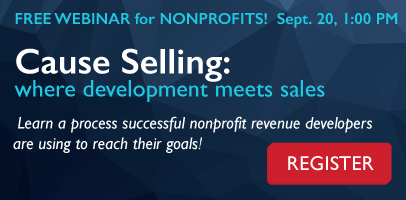
Cause Marketing is a buzzword bantered about by many in the nonprofit sector. To some, the concept is a proven method to help organizations solve business problems via an association with a worthwhile cause. To others, it is merely a tactic designed to pitch and sell sponsorships to nonprofit events and initiatives.
In order for a nonprofit development officer to engage in cause marketing successfully, they need to take some time to understand the needs of their prospect before presenting a proposal and asking for money. This understanding enables the development of a proposal customized for the prospect based on a business problem, challenge or opportunity. Simply put, one does not exist without the other—without an understanding of needs cause marketing cannot happen and the ask is merely just another ask.
“Seek first to understand then be understood.” Stephen Covey
Many nonprofit development officers ask before they assess needs. For example, it is all too easy to ask a financial institution to sponsor a nonprofit initiative based on belief in the nonprofit mission instead of taking the time to discover the financial institution is launching an new credit card and needs help with applications. Image the power of linking this need with a nonprofit event—like a fun run or walk—that attracts thousand of credit worthy people. This transforms the ask to win-win proposition that helps the cause and the corporate partner!
Here’s a step-by-step process that world calls nonprofit revenue developers follow to understand client needs—feel free to take it for a test drive:
Build Rapport
- Make a personal connection, establish some rapport.
- Repeat your pre-call contracting (clarify expectations—yours and theirs).
- Brief Agenda (make reference to the VBR you used to set the meeting).
- Discuss how you do business.
- Ask some easy-to-answer, not-risky questions to continue establishing your credibility.
Uncover Needs
- Probe for a broad range of potential needs, problems, challenges, and opportunities, some of which could turn into good assignments.
- Use the Needs/Notes note-taking system (divide a sheet of paper in half vertically and list needs on one side and notes on the other).
- Circle those needs that may be an assignment. It’s an assignment if it is important enough for the client to lose sleep over and spend money to solve AND it’s a problem we can help with (see credit card assignment mentioned above.
- The needs phase may be complete when you have 2 or 3 promising assignments.
Agree on an Assignment
- Summarize the needs you noted on your page.
- Ask if anything is missing from list.
- Ask prospect to prioritize them. Which is most important? Most urgent? Focus on the most important need you have the capabilities to address.
- Test the emerging “assignment” by asking questions about ROI measurement, already-existing plans, potential resources to solve the problem, and how soon the prospect wants to see potential solutions.
- Agree on one assignment. This is something the prospect wants help with and wants to work shoulder-to-shoulder with you.
Analysis of the Assignment
- Open up the questioning again. Now your intent is not to learn about a full range of potential needs, but to get in-depth information about the assignment uncovered.
- Ask these types of questions (you may want to use a few of these and then draft some of your own as well). What makes this need important? What has prompted it to go to the top of your priority list? What makes it tough? What would success look like? What are some of the things you would need to see in the ideal solution? Why don’t you have a solution already?
- Floating preliminary ideas and trial balloons related to your nonprofit events and initiatives is a natural part of this process. You’re not necessarily trying to solve the problem or pitch your sponsorship right then and there; rather, you’re using these devices to learn more so you can build a buyable proposal (a better ask).
Contracting of Next Steps
- Ask the prospect, What else should we be talking about? Do you have any questions for me?
- Agree on next steps in the process. Announce your tasks. Leave the prospect at least one task.
To learn more about this needs analysis process register for the Cause Selling webinar on September 20, 1:00 PM EST. You’ll learn the following:
- How to identify the best prospects
- Ways to set more face-to-face appointments
- The types of questions to ask to uncover needs
- Plus much more!


